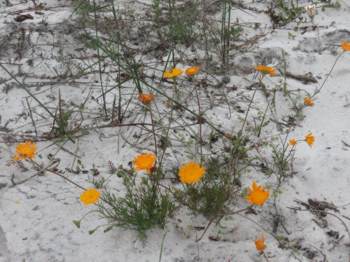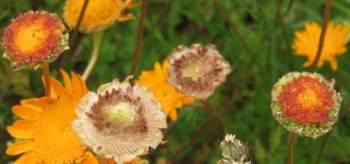Cotula duckittiae
Cotula duckittiae (L. Bolus) Bremer & Humphries
Family: Asteraceae
Common names: Bokbaai buttons
Introduction
This adorable orange flowered annual normally heralds the beginning of spring when it starts flowering in September.

Description
Description
This is a robust annual of 200-400 mm. The finely divided leaves are alternate, bi- or tri-pinnatisect; lobes linear to filiform.

The flower heads are solitary on slender stalks and have conspicuous orange, button-shaped, yellow disc and ray florets. Flowering is from September to early October.

Conservation Status
Status
Cotula duckittiae is threatened and has a status of VU (Vulnerable) (Raimondo et al. 2009). It is currently only known from very few locations where its habitats are under threat from urban expansion, invasive alien vegetation and crop cultivation.
Distribution and habitat
Distribution description
This species is found on sandy coastal slopes from Yzerfontein to Bokbaai along the West Coast of South Africa.

Derivation of name and historical aspects
History
The genus name Cotula is derived from the Greek, kotule, meaning ‘cup', referring to the receptacle of the flower head which remains on the flower-stem after the flower has died.
Ecology
Ecology
Not much is known about its pollination. The seed is light and small and therefore adapted to be dispersed by wind.
Uses
Use
No cultural or medicinal uses have been recorded.
Growing Cotula duckittiae
Grow

Sow seed in early autumn in seed beds or seed trays using a light, well-draining medium which is placed in a sunny position.
The medium could be a light, sandy soil or a mixture of bark, compost or river sand. Ordinary coarse river sand will also suffice.
Sow the light seeds evenly on a windless day, water gently and cover with a thin layer of sand or bark. The seed will germinate within two to three weeks. Prick seedlings out from the beds or trays as soon as they are large enough to be handled and plant in designated area.
This annual doesn't seem to enjoy having wet feet for too long. Therefore in areas of high winter rainfall, it is perhaps best displayed on a slope or in a rockery.
Seed will be ready for harvesting from October onwards.
Cotula duckittiae peforms well in en masse plantings, interplanted with various other annuals or as a seasonal border plant amongst other herbaceous perennials. Some of the various other annuals which either occur with this species in its natural habitat or which have been found to complement it rather well include: Felicia dubia (dwarf felicia), blue F. heterophylla , Ursinia anthemoides (marigold), U. speciosa (Namaqua-ursinia), U. cakilefolia , Heliophila coronopifolia (blue flax), Senecio elegans (wild cineraria), Dimorphotheca sinuata (Namaqualand daisy), and D. pluvialis (rain daisy or white Namaqualand daisy).
Cotula duckittiae has no known pests or diseases.
References
- Goldblatt, P. & Manning, J. 2000. Cape Plants. A conspectus of the Cape flora of South Africa. Strelitzia 9. National Botanical Institute, Pretoria & Missouri Botanical Garden, Missouri.
- Manning, J.C., Goldblatt, P. 1996. West Coast. South African Wild Flower Guide 7. Botanical Society of South Africa, Cape Town
- Jackson, W.P. 1980. Wild flowers of the Fairest Cape. Howard Timmins (Pty) Ltd. Cape Town
- Powrie, F. 1998. Grow South African Plants. A gardener's companion to indigenous plants. National Botanical Institute, Cape Town.
- Raimondo, D. et al. 2009. Red list of South African plants. Strelitzia 25. SANBI (South African National Biodiversity Institute), Pretoria.
- Stearn, W. 2002. Stearn's dictionary of plant names for gardeners. Timber Press. Portland, Oregon.
Credits
Roger Oliver
Kirstenbosch National Botanical Garden
November 2014
Plant Attributes:
Plant Type: Bi/Annual
SA Distribution: Western Cape
Soil type: Sandy
Flowering season: Spring
PH: Alkaline, Neutral
Flower colour: Yellow, Orange
Aspect: Full Sun
Gardening skill: Easy
Special Features:
Horticultural zones







Rate this article
Article well written and informative
Rate this plant
Is this an interesting plant?
Login to add your Comment
Back to topNot registered yet? Click here to register.